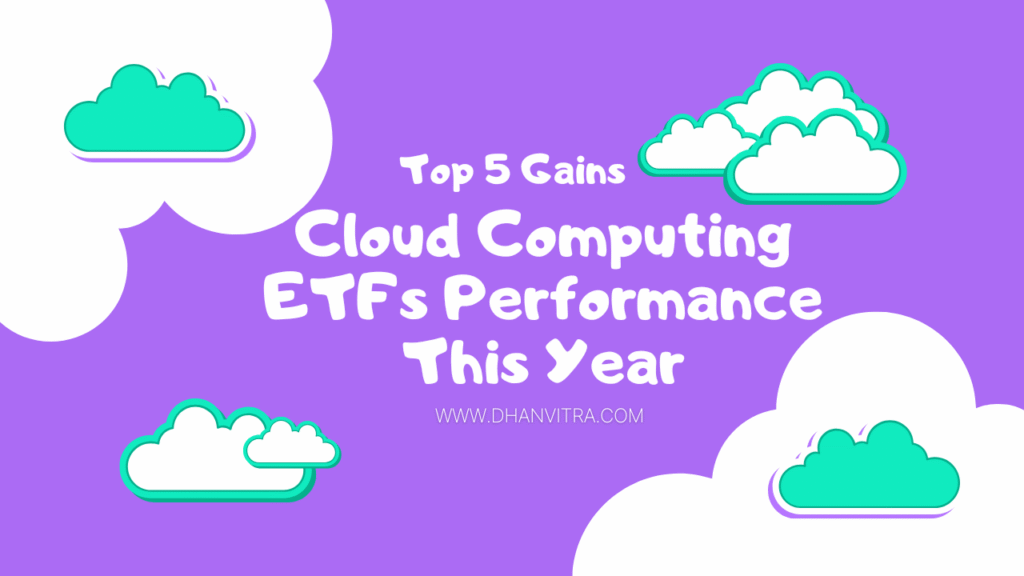
At Dhanvitra, we believe that smart investing starts with understanding the forces shaping tomorrow’s economy. One of the biggest game-changers in recent years has been Cloud Computing ETFs Performance This Year —the invisible engine running everything from online banking to video streaming.
For investors, the rise of the cloud isn’t just a tech story—it’s a wealth-building opportunity. Instead of betting on a single company, many are turning to Cloud Computing ETFs (Exchange-Traded Funds) to capture the growth of an entire sector in one move.
This year, cloud ETFs have been on a remarkable run, outperforming many traditional assets. From powering AI to enabling hybrid work, cloud adoption is driving a new wave of profits for investors who know where to look. In this article, we’ll explore how cloud computing ETFs are performing in 2025, what’s fueling their rise, and highlight the Top 5 ETFs delivering the strongest gains.
If you’re new to the world of investing, let’s make this simple. Imagine you want to invest in the booming cloud computing industry, but you don’t want to risk putting all your money into one company like Amazon Web Services, Microsoft Azure, or Google Cloud. That’s where ETFs—or Exchange-Traded Funds—step in to save the day.
A cloud computing ETF is essentially a basket of carefully selected companies that operate in the cloud ecosystem. These include big names providing infrastructure, mid-sized firms offering SaaS (Software as a Service), and even smaller innovative startups working on niche cloud technologies. Instead of guessing which single company might outperform, you get broad exposure across the sector.
Another advantage is liquidity. ETFs trade on stock exchanges just like normal stocks, so you can buy and sell them in real time. This is very different from mutual funds, which are priced only once a day. That flexibility has made ETFs increasingly popular with investors globally.
Why focus on cloud ETFs specifically? From Netflix streaming into your living room to hospitals securely storing patient data, the cloud is woven into everyday life. Investors want a piece of that growth, and cloud ETFs give them the chance to participate without betting the farm on one company.
Table of Contents
Key Drivers of Cloud Computing Growth
When you ask why cloud computing ETFs are performing well this year, the answer lies in the forces driving global cloud adoption. These aren’t temporary trends—they’re megashifts in how businesses and societies operate.
Artificial intelligence is the first and perhaps the biggest driver. AI tools require enormous amounts of processing power and data storage, and the cloud is the only scalable way to handle that. Every time you interact with an AI chatbot, request a recommendation on a shopping app, or run a machine learning model, the cloud is doing the heavy lifting behind the scenes. That demand has sent cloud infrastructure providers into overdrive, which in turn fuels ETF performance.
Then there’s the transformation of the workplace. Remote work is no longer just a pandemic solution—it’s a permanent part of corporate culture. Hybrid offices rely on cloud platforms for communication, collaboration, and security.
Security and compliance are another huge factor. With so much sensitive data moving across borders, businesses and governments need reliable cloud partners. From banking transactions to defense systems, secure cloud solutions are non-negotiable. This urgency has increased investment in cybersecurity, which goes hand in hand with cloud adoption.
Finally, governments themselves are adopting cloud at a massive scale. From smart cities in Asia to digital governance in Europe, public institutions are embracing the cloud to serve citizens better. That institutional backing ensures that cloud adoption is not just a corporate trend but a worldwide movement.
Performance of Cloud Computing ETFs in 2025
Now, let’s talk numbers and trends. 2025 has been a year of contrasts in global markets—tech stocks have faced volatility, yet cloud ETFs have managed to deliver impressive returns. Why? Because cloud is not just another tech fad, it has become a fundamental utility, like electricity or the internet itself.
One noticeable trend this year has been the outperformance of ETFs with greater exposure to SaaS companies. While infrastructure providers like AWS or Azure remain dominant, the software companies that build tools on top of cloud platforms have shown even stronger revenue growth. This explains why ETFs such as the WisdomTree Cloud Computing ETF (WCLD) have surged ahead of peers.
Another performance driver is diversification within the ETFs themselves. Some funds have taken a more global approach, including exposure to Asian and European cloud players, while others remain US-centric. Interestingly, those with international holdings benefited from faster adoption rates in emerging markets, where businesses are leapfrogging traditional IT setups and going cloud-first.
It’s also worth noting that macroeconomic factors like interest rates and inflation haven’t slowed down the cloud sector as much as they have impacted other areas of technology. The reason is simple: companies cannot afford to stop investing in cloud infrastructure. Without it, they fall behind in efficiency, scalability, and security.
As of mid-2025, the best-performing ETFs have posted double-digit gains, outpacing broader tech indexes. That’s not just luck—it’s a sign that cloud has moved into a new phase of maturity, one where demand is both steady and expanding.
Top 5 Cloud Computing ETFs With the Best Gains
The global cloud market in 2025 has been shaped by artificial intelligence integration, rising enterprise demand, and an unprecedented need for secure digital infrastructure. Among dozens of ETFs, five have emerged as clear leaders this year, delivering strong returns for investors who wanted exposure to this high-growth sector. The WisdomTree Cloud Computing ETF (WCLD), the Global X Cloud Computing ETF (CLOU), the First Trust Cloud Computing ETF (SKYY), and the iShares Expanded Tech-Software Sector ETF are all examples of these. The Direxion Work From Home ETF (WFH) and the IGV.
Each ETF represents a unique investment approach, from focusing on innovative startups to backing well-established software giants. Their performance has not only beaten many traditional sectors but also highlighted the resilience of cloud-based business models.
Detailed Analysis of Each ETF
WisdomTree Cloud Computing ETF (WCLD)
WCLD has built its reputation by leaning heavily toward smaller, high-growth cloud firms. Unlike other funds dominated by mega-cap companies, WCLD gives more weight to emerging innovators—firms that may not yet be household names but are driving niche transformations in software-as-a-service (SaaS) and cloud infrastructure. This year, WCLD’s gains were fueled by demand for generative AI tools, cybersecurity platforms, and developer-friendly cloud solutions. For investors seeking growth beyond the giants, WCLD has proven to be a rewarding choice.
Global X Cloud Computing ETF (CLOU)
CLOU has made waves by concentrating on SaaS companies, especially those offering subscription-based models that generate consistent revenue. The predictability of cash flow in SaaS firms has helped CLOU deliver steady performance even in periods of market volatility. Many of CLOU’s top holdings benefited from global adoption of AI-driven productivity tools, video conferencing, and collaboration software. For global investors looking for stability paired with growth, CLOU stands out as one of the strongest performers this year.
First Trust Cloud Computing ETF (SKYY)
SKYY is often considered the pioneer in the cloud ETF space, having launched long before many of its competitors. Its performance in 2025 reflected its diversified approach—it includes not just software providers but also data centers, networking companies, and hardware manufacturers supporting the cloud ecosystem. This broad exposure means SKYY thrives in multiple scenarios, whether demand rises for AI chips, enterprise cloud services, or hybrid IT infrastructure. For long-term investors, SKYY continues to be a benchmark in cloud computing investments.
iShares Expanded Tech-Software Sector ETF (IGV)
IGV offers exposure beyond just cloud, dipping into the wider software universe. This year, its gains came largely from established names in the productivity and enterprise software market. Many of these firms reinvented themselves by embedding AI capabilities into existing cloud platforms, ensuring they stayed competitive. IGV is less volatile than some pure-play cloud ETFs, making it appealing for investors who want broader tech exposure with a reliable cloud component.
Direxion Work From Home ETF (WFH)
WFH may seem like a niche play, but its relevance remains high as hybrid and remote work models continue worldwide. The companies in this ETF thrive by supporting digital collaboration, cloud security, and virtual productivity tools. Its performance this year highlighted how remote work is no longer a pandemic-driven trend but a long-term structural shift. While WFH is smaller compared to the others, it has offered strong gains for those betting on the permanence of distributed workforces.
Risks and Challenges
While the gains in cloud ETFs have been remarkable, no investment is without risks. The biggest challenge lies in market volatility. The technology sector often experiences sharp ups and downs, and cloud ETFs are no exception. Sudden shifts in interest rates or investor sentiment can lead to temporary pullbacks, even when the long-term story remains strong.
Another concern is regulatory scrutiny. Governments worldwide are paying closer attention to data privacy, cybersecurity standards, and monopoly-like behaviors in large tech firms. These regulations may affect profitability or slow expansion for some cloud companies.
The third challenge comes from intense competition. Cloud computing is one of the most competitive industries, with giants like Amazon, Microsoft, and Google fighting alongside smaller disruptors. To remain relevant, companies must constantly innovate, which adds pressure and can lead to uneven financial performance.
Investment Strategies for Cloud ETFs
Investors considering cloud ETFs should think carefully about strategy. A long-term approach often works best because the cloud sector continues to grow steadily with digital transformation across industries. Holding for several years allows investors to benefit from compounding growth, even if short-term volatility causes hiccups.
That said, short-term investors can also capitalize on momentum during earnings seasons or when major cloud adoption announcements occur. However, this requires close monitoring and risk tolerance.
Diversification remains crucial. While cloud ETFs are attractive, blending them with other tech and non-tech ETFs can balance risk and reduce dependency on one sector. Pairing cloud ETFs with semiconductors, AI, or even renewable energy ETFs can create a resilient portfolio.
Lastly, risk management cannot be ignored. Setting stop-loss orders, limiting exposure to a single ETF, and regularly reviewing performance are smart ways to protect capital while enjoying the growth potential of cloud computing.
Future Outlook of Cloud Computing ETFs
When we look at the road ahead, cloud computing ETFs seem positioned for a future full of opportunities but also marked by competition and innovation challenges. One of the strongest tailwinds is the rise of artificial intelligence. AI is no longer just about chatbots or smart assistants—it requires vast processing power and storage, all of which live in the cloud. As companies adopt AI at scale, the demand for cloud infrastructure will skyrocket, and ETFs holding these companies could benefit directly.
Another driver is the rise of edge computing. While the cloud centralizes data, edge computing brings processing closer to the user—think of smart cities, autonomous cars, and IoT devices. This blend of cloud and edge will reshape digital infrastructure and provide new investment opportunities. ETFs that diversify into companies pioneering these hybrid solutions may see stronger gains in the coming years.
We also can’t ignore quantum computing. Although still in its early stages, quantum has the potential to revolutionize cloud services. Once breakthroughs happen, cloud providers will likely be the first to integrate quantum technology into their offerings, creating a whole new wave of growth. Investors looking at long-term horizons may find this trend particularly exciting.
On a global scale, cloud adoption is spreading rapidly in emerging markets. Nations across Asia, Africa, and Latin America are digitizing industries at a record pace. As local businesses and governments adopt cloud services, the global market share of cloud providers will expand, which will be reflected in ETFs holding those stocks.
The next five years are unlikely to be smooth sailing—regulations, competition, and data privacy concerns will always create bumps in the road. However, the overall trajectory points upward. As long as the world continues moving toward digital-first living, cloud computing ETFs will remain a powerful vehicle for investors seeking exposure to this transformation.
Conclusion of Cloud Computing ETFs Performance This Year
Cloud computing ETFs have proven to be more than a passing trend. They represent the backbone of the digital economy and have become one of the most attractive ways for investors to diversify their portfolios while tapping into the growth of next-generation technologies. This year’s performance already shows how resilient and profitable the sector can be, even in times of market uncertainty.
What makes them particularly appealing is their balance of risk and reward. Instead of gambling on one cloud company, investors gain access to a basket of leaders and innovators shaping the digital future. The coming years promise even more growth with AI, edge computing, and quantum breakthroughs leading the charge.
If you’re an investor looking for exposure to long-term technological innovation, cloud computing ETFs deserve a place on your watchlist. The future may not be predictable, but one thing is clear: as the world becomes more digital, the cloud will always be in demand.
FAQs
What are the best-performing cloud ETFs this year?
The First Trust Cloud Computing ETF (SKYY), the Global X Cloud Computing ETF (CLOU), and the WisdomTree Cloud Computing ETF (WCLD) are among the top performers in 2025. The robust earnings reports from SaaS and infrastructure vendors helped these ETFs gain popularity.
Are cloud ETFs a safe investment?
No investment is entirely safe, but cloud ETFs offer reduced risk compared to picking individual tech stocks. Since they include a diversified basket of companies, the impact of one underperformer is minimized.
How do I choose between different cloud ETFs?
It depends on your goals. Some ETFs focus on smaller, high-growth firms, while others include established software giants. If you want growth potential, WCLD and CLOU may fit. If you prefer stability with steady returns, SKYY or IGV might be better.
Can cloud ETFs beat the S&P 500 in the long term?
Historically, tech-focused ETFs often outperform broad indexes during growth phases but can lag during downturns. With cloud adoption accelerating, there’s potential for cloud ETFs to outperform the S&P 500 in the long term, though short-term volatility is expected.
Should beginners invest in cloud ETFs now?
Yes, beginners can consider them because ETFs simplify investing in the tech sector. However, it’s wise to start small, diversify your portfolio, and invest with a long-term perspective. Cloud is a growing industry, and beginners who stay patient may benefit significantly.










Incredible performance from those top cloud computing ETFs! It’s a great reminder of how important cloud tech is becoming in our daily lives. Keep an eye on these for sure!
Loving the gains from these cloud computing ETFs! It’s exciting to watch technology evolve and see investments pay off like this. Can’t wait to see what the future holds!
Wow, it’s amazing to see how well these cloud computing ETFs have performed this year! The growth is impressive and shows just how much potential there is in this sector.
These cloud computing ETFs are really killing it this year! It’s fascinating to see which ones made the best gains—definitely worth considering for anyone looking to invest in tech!
So impressed by the performance of these cloud computing ETFs! They’re proving that innovation really drives success in investing. Here’s to more growth ahead!